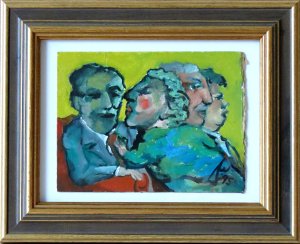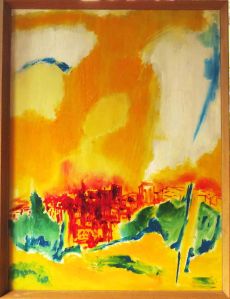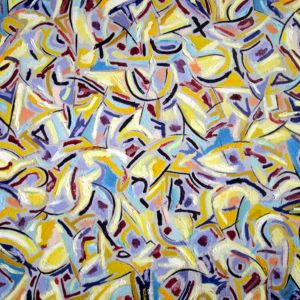About DAPHNE MASON (1928-2020)
At 92, Daphne Mason had well over 50 years of unbroken painting and mixed media work behind her, and was still drawing up until a week before her death in June 2020.
A finalist in several major NZ art awards in the 70s and 80s before moving overseas to London, her works are held in collections across Europe, as well as in America, China, South East Asia and Australasia. Returning home again to NZ in 2003 after a significant period abroad, her conservation block in Silverdale provided the space for distilling her thoughts and giving them form.

Oil on board. Wooden frame with gilt detail and glass.
21.3cm H x 26.3cm W.
Copyright Daphne Mason.
Private Collection.

92.5cm H x 78 W.
Copyright Daphne Mason
A true colourist, Daphne worked in a range of media, yet seemed most at home with the richness of oils. Her paintings revealed an ongoing exploration of colour and its visual “weight” in the balance of a canvas, as well as a lyrical exploration of how mark making coaxes out form.
To sit with a Daphne Mason, particularly the larger works, is to enter a world where one’s eyes retrace the journey of brush upon canvas again and again. In the colourist celebrations the result is pure delight; with her more political works the result is a sobering meditative pause.
Daphne Mason was a deeply spiritual artist, and that expressed itself in her attachment to the land, as well as in her commentary on humanity. She figured in the crowd in one “Crucifixion”, and was unafraid to use self-portraits to reflect the truth of the moment at the cost of vanity. Daphne addressed the challenge of both art and life fearlessly, and with gritty good humour, or (more rarely) despair.
Daphne was part of a small group of New Zealand female artists of her generation, who began her journey with no hope that her family could underwrite her art in any way; yet she managed to persevere and overcome for nearly 50 years. After years of needing to support herself, her marriage and the birth of two children put additional demands on her time and attention, without reducing her resolve.

Private collection
She began her exhibition career with a show at Hayah’s Gallery in Remuera in 1967. This was followed by shows at: Moller’s Gallery (1970 and a group show in 1971), Osborne Gallery (1971); New Vision Gallery (1975); Spinning Pot (1977); New Vision Summer Show (1977); New Vision Gallery (1981); and the John Leech Gallery (1986).
She had works selected in the following art awards: Tokoroa Art Award (1973); Wanganui Sarjeant Gallery Award for Contemporary Art (1973); Benson and Hedges Art Award (1980); and the Whanganui Art Awards, Sarjeant Gallery (1984) where she had two large works selected – almost unheard of at that time.
In 1986 the Sarjeant also gave her a retrospective, an acknowledgement of the under-exposure of female artists like Daphne who had worked largely unrecognised despite their years of solid achievement in their field.

92.5cm H x 78 cm W.
Copyright Daphne Mason.
Private collection
A move to London at the cost of her spacious studio in Parnell brought the challenge of the changeable and sombre West London light and much more limited space in which to create. Yet Daphne continued to show in group shows locally in London, including the Soho Festival in 1991, and was given a curated show at the Museum of Modern Art in Wales that same year.
Her husband’s dramatic decline in health over a period of years caused her to make the inevitable choice of focusing on his care, while returning to that pattern of painting in every precious corner of time afforded to her. His death in 2002 brought to an end a partnership that had provided her with enormous intellectual stimulation and happiness.

50.5cm H x 50.5cm W. Copyright Daphne Mason.
Inevitably her art again provided a means of reflection and gradual healing, as did her return to “Whenuakura” (“precious land”), where she lived and painted with great discipline and vigour until the final weeks of her life.
Despite the challenges such a lifestyle brought, Daphne was still constantly exploring new ideas and techniques, forging new friendships, and maintaining a quality of life that is a testament to her courage and generosity.

45.5cm H x 45.5cm W.
Oil on canvas stretcher. Unframed.
Copyright Daphne Mason.
Private collection
Daphne’s late works, especially those from 2012 onwards, showed a return in terms of their construction to the themes of puzzles and implied connections that she explored in the past. The pared down approach to the canvas displays the almost mathematical precision with which Daphne went about the task of developing each work, a study in colour and balance.
Sometimes soothing or joyous, sometimes startling in their choice of colour, or almost harking back to the Art Deco tones of her Napier childhood, these works demonstrate that, in her late 80’s and early 90’s, Daphne was producing some of her greatest work ever with great vigour and delight.
Her latest works from 2016 onwards in particular, also reflect not only her connection to the land, but also her deepening concern over the encroaching property developments threatening her beloved native bush. This is reflected in the works selected for her 2017 exhibition entitled Sacred Land Collection, which ran at Auckland’s Studio One Toi Tu Gallery in Ponsonby during April / May.


Composition 59, 2016. 75cm H x 75cm W.
Oil on canvas stretcher. Unframed
Copyright Daphne Mason


